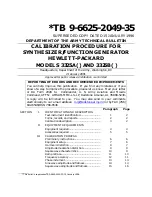
Tone Parameters
24
PITCH ENVELOPE
Parameter
[
K
] [
J
] buttons
Value
[-] [+] buttons
Explanation
Depth
-100–+100
Adjusts the effect of the Pitch Envelope.
Higher settings will cause the pitch
envelope to produce greater change.
Negative “-” settings will invert the shape
of the envelope.
If OSC Type is other than Virtual Analog,
this is limited to ±63.
Velocity Sens
-100–+100
Keyboard playing dynamics can be
used to control the depth of the pitch
envelope.If you want the pitch envelope
to have more effect for strongly played
notes, set this parameter to a positive “+”
value. If you want the pitch envelope to
have less effect for strongly played notes,
set this to a negative “-” value.
Time 1 Velocity
Sens
-100–+100
This allows keyboard dynamics to affect
the Time 1 of the Pitch envelope.
If you want Time 1 to be speeded up for
strongly played notes, set this parameter
to a positive “+” value. If you want it to
be slowed down, set this to a negative
“-” value.
Time 4 Velocity
Sens
-100–+100
Use this parameter when you want key
release speed to affect the Time 4 value of
the pitch envelope.
If you want Time 4 to be speeded up for
quickly released notes, set this parameter
to a positive “+” value. If you want it to
be slowed down, set this to a negative
“-” value.
Time Keyfollow
-100–+100
Use this setting if you want the pitch
envelope times (Time 2–Time 4) to be
affected by the keyboard location. Based
on the pitch envelope times for the C4
key, positive (+) value will cause notes
higher than C4 to have increasingly
shorter times, and negative (-) value will
cause them to have increasingly longer
times. Larger settings will produce
greater change.
0
C4
C3
C2
C1
C5
C6
C7
-50
-100
+50
+100
Key
Time
Time 1–4
0–1023
Specify the pitch envelope times (Time
1–Time 4).
Higher settings will result in a longer
time until the next pitch is reached. (For
example, Time 2 is the time over which
the pitch changes from Level 1 to Level 2.)
*
If ADSR Envelope Switch is ON, the Pitch Env
Time 2 has no effect.
T1
T2
T3
T4
L1
L0
Pitch
Note on
T
:
Time
L
:
Level
L3
L2
Note off
Time
L4
Level 0–4
-511–+511
Specify the pitch envelope levels (Level
0–Level 4). It determines how much the
pitch changes from the reference pitch
(the value set with Coarse Tune or Fine
Tune on the Pitch screen) at each point.
Positive “+” settings will cause the pitch
to be higher than the standard pitch,
and negative “-” settings will cause it to
be lower.
*
If ADSR Envelope Switch is ON, only Pitch Env
Level 3 (Sustain) has an effect. Also in this case,
settings with a negative value are ignored.
FILTER
Parameter
[
K
] [
J
] buttons
Value
[-] [+] buttons
Explanation
Filter Type
TVF, VCF
Selects the type of filter.
*
TVF stands for Time Variant Filter, a filter that
lets you specify in detail how the frequency
components of the sound change over time.
If you select VCF, the polyphony will be lower
than if you select TVF.
TVF Type
TVFSelects the type of filter.
*
If Filter Type is set to VCF, this will be LPF.
OFF
No filter is used.
LPF
Low Pass Filter. This reduces the volume
of all frequencies above the cutoff
frequency (Cutoff Frequency) in order to
round off, or un-brighten the sound.
This is the most common filter used in
synthesizers.
BPF
Band Pass Filter. This leaves only the
frequencies in the region of the cutoff
frequency (Cutoff Frequency), and cuts
the rest. This can be useful when creating
distinctive sounds.
HPF
High Pass Filter. This cuts the frequencies
in the region below the cutoff frequency
(Cutoff Frequency). This is suitable for
creating percussive sounds emphasizing
their higher tones.
PKG
Peaking Filter. This emphasizes the
frequencies in the region of the cutoff
frequency (Cutoff Frequency). You can
use this to create wah-wah effects by
employing an LFO to change the cutoff
frequency cyclically.
LPF2
Low Pass Filter 2. Although frequency
components above the Cutoff frequency
(Cutoff Frequency) are cut, the sensitivity
of this filter is half that of the LPF. This
makes it a comparatively warmer low
pass filter. This filter is good for use with
simulated instrument sounds such as the
acoustic piano.
*
If you set
“LPF2,”
the setting for the Resonance
parameter will be ignored (p. 25).
LPF3
Low Pass Filter 3. Although frequency
components above the Cutoff frequency
(Cutoff Frequency) are cut, the sensitivity
of this filter changes according to the
Cutoff frequency. While this filter is also
good for use with simulated acoustic
instrument sounds, the nuance it exhibits
differs from that of the LPF2, even with
the same TVF Envelope settings.
*
If you set
“LPF3,”
the setting for the Resonance
parameter will be ignored (p. 25).
VCF Type
1–4
This parameter is effective when Filter
Type is VCF.
Each setting simulates the operation of
an analog synthesizer’s LPF. In particular,
2–4 are types that are suitable for
reproducing synthesizer sounds of the
past.
Filter Slope
-12, -18, -24 [dB/
Oct]
This button selects the slope (steepness)
of the filter.
For VCF, you can choose -12, -18, or -24.
For TVF, only -12 or -24 can be selected.
If Filter Type is TVF, the following
limitations apply.
5
You can specify only -12 dB or -24
dB. If you specify -18 dB, the sound
generator operates internally with the
-12 dB setting.
5
If you specify -24 dB, the polyphony
will be lower than if you specify -12 dB.
HPF Cutoff
0–1023
Specifies the cutoff frequency of the -6 dB
high-pass filter.
*
This is effective if Filter Type is VCF.















































